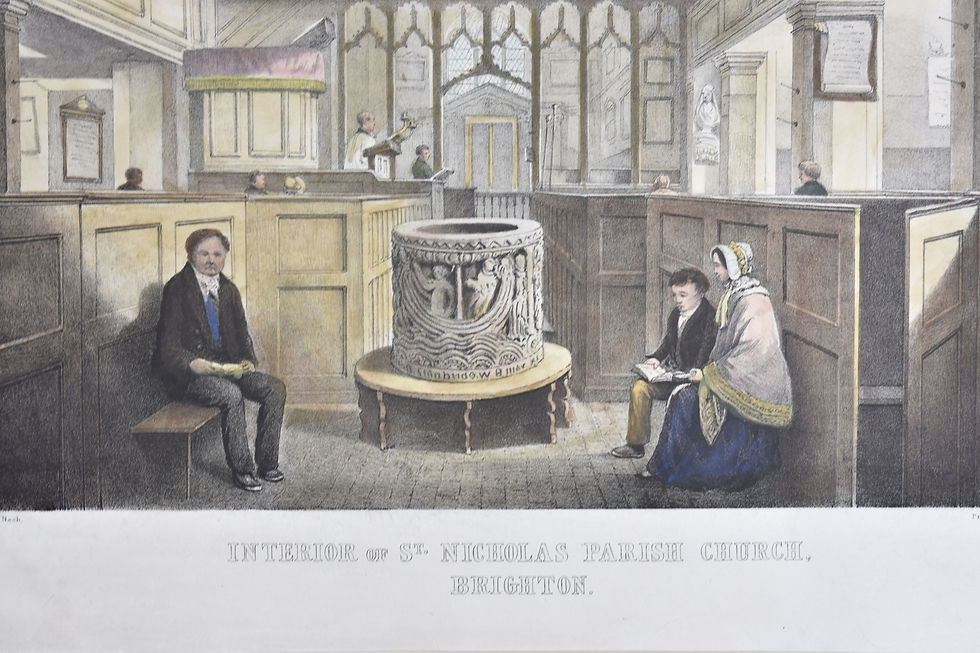Interior of St Nicholas Parish Church, Brighton
St Nicholas's Church in Church Street, Brighton is the oldest recorded church in the city. Parts of the original late 14th centry building survive in the tower, chancel arch and nave arcadebut the rest of the church was rebuilt in the 1850s with later additions in the 1870s. This charming lithograph records the church before the building work had begun.
The wooden pews were removed at the time of the rebuilding and the furniture of the church rearranged.
In the centre of the image is a Norman font, beautifully carved with four scenes from the Bible. Three of the scenes have been identified as 'the Last Supper', 'Christ's baptism', and scenes from the Life of Nicholas of Myra (patron saint of the church). The fourth panel has not been identified with certainty.
How the font got there is not clear as it is much older than the church. It may have come from an earlier Brighton church mentioned in the Domesday book of which there is no trace but the quality of its workmanship makes this debatable. The rich and powerful Clunaic Priory at Lewes held the right to appoint the priest of the church (known as advowson) and it may be possible that the font was carved by stonemasons working on the Priory. Today the font is now situated at the west end of the nave.
The Artist.
Frederick Nash (1782–1856) was watercolour painter and architectural draughtsman. Early in his career he worked for the architect Robert Smirke and went on to produce drawings for several well known publications including Britton and Brayley’s Beauties of England and Wales and Britton’s Architectural Antiquities. He published A Series of Views of the Collegiate Chapel of St George at Windsor, 1805 for which he did both the drawings and etchings. He worked extensively in Britian and travelled to Switzerland and France and in Paris worked for a time as assistant to Thomas Lawrence. He moved to Brighton in 1834 where he continued working until his death in 1856. Much of his work in this period is on recording buildings and scenes in Sussex. He died at his home 4 Montpelier Road and his possessions which included the palette of Thomas Lawrence were sold in Brighton. Nash is buried in the extra-mural cemetery in Brighton.
Charles Joseph Hullmandel ( 1789 – 1850) was born in London, where he maintained a lithographic establishment on Great Marlborough Street from about 1819 until his death. As a young man, s Hullmandel studied art and spent several years living and working in continental Europe. He learned printmaking and printed many of his own works. In 1818, he set up a printing press in London after a visit to Munich with Rudolph Ackermann, and went on to study chemistry under Michael Faraday for the purpose of improving his printing.During the first half of the 19th century Hullmandel became one of the most important figures in the development of British lithography, and his name appears on the imprints of thousands of lithographic prints. He developed a method for reproducing gradations in tones and for creating the effect of soft colour washes which enabled the printed reproduction of Romantic landscape paintings of the type made popular in England by J. M. W. Turner. Hullmandel's essay The Art of Drawing on Stone (1824) was an important handbook of lithography.
Hullmandel went into partnership with Walton ca. 1843 and that after Hullmandel's death in 1850 the imprint of Hullmandel & Walton continued for about a decade.
Interior of St Nicholas Parish Church, Brighton, Frederick Nash - Antique Print
Image Numbers: 1187
Title: Interior of St Nicholas Parish Church, BrightonDate: c. 1840
Artist: Frederick Nash
Printed by: Hullmandel & Walton
Medium: TInted Lithograph
Framed size (h x w): 481 x 569mm

